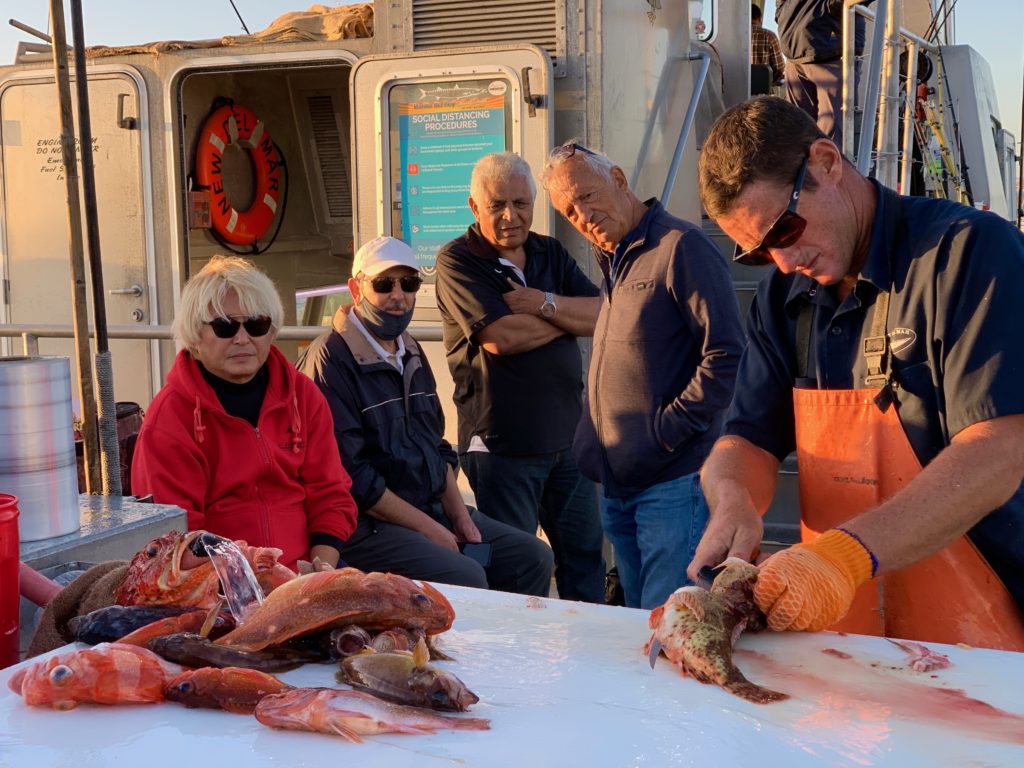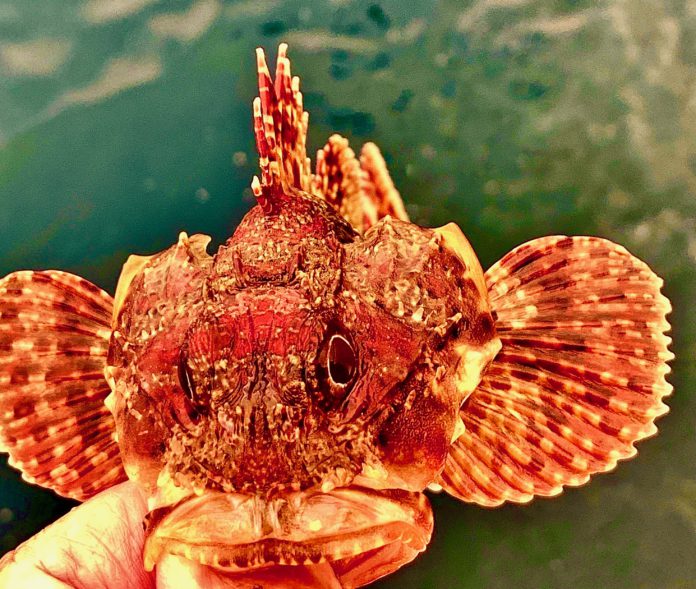
BY JOHN DICKENS
“Ahhh! He stuck me!” If you’ve fished for sculpin long enough along the West Coast, you’ve no doubt heard this cry, or experienced it yourself. Not fun.
Sculpin, a member of the scorpaenidae family (scorpion fishes), are also called scorpions, rattlesnakes, rattlers, stingers and red devils. Known for having spines filled with toxin that can inflict an extremely painful sting if they puncture the skin, they’re also one of the best eating fish around. With that understood, most fishermen know to handle these tasty critters verrry carefully.
Problems can arise however when someone is careless, or an inexperienced fisherman or fisherwoman excitedly swings one of these sculpin over the rail without knowing the damage they can cause. If you’ve ever seen someone get stuck by a flying sculpin, you know what I mean. Generally a crewmember or fellow fisherman will shout out a warning when they sense the newbie doesn’t know how to handle their catch. Sometimes the warning doesn’t happen fast enough. And if the unsuspecting angler grabs the sculpin by the midsection with their bare hand, it can definitely ruin their day.
Sack-fillers
As local fish populations change, either due to migratory patterns, cyclical conditions or Department of Fish and Wildlife restrictions, the go-to “sack-filler” species for party boat captains have also changed. A few decades ago it was bonito, then summer time sand bass that migrated into our waters in unimaginable numbers. Later it was rockfish. With seasonal restrictions closing the rockfish option for January and February, and other surface or bottom gobblers not wanting to play so much, the go-to dinner plate target becomes sculpin, with a side of sand bass. Captains can pretty much rely on “Ol’ Red” to fill their patrons’ sacks and keep the fillet table busy.
With that in mind, here are five things you should know if you want to catch sculpin:
1 – Where they live and what they eat
Sculpin are typically found anywhere from shallow tide pools to several hundred feet deep, and prefer rocky hard-bottom habitats. While they can be caught over rocky reefs in 50- to 70-feet, the challenge is avoiding the nursery grounds where many sculpin are under the 10-inch minimum length requirement. Party boats generally opt to fish deeper water, 120- to 250-feet, as there’s usually more volume there and the deeper water often holds bigger fish. Bigger is a relative term, however, as a two-pounder is considered big and the largest ever caught is said to be less than four pounds.
Sporting a red/orange mottled skin color, with a disproportionately large head and pectoral fins, sculpin hunker down in rocky terrain ranging from the Uncle Sam Banks in Mexican waters to the central coast of California and beyond. Favorite chow on the sculpin’s plate consists of crabs, squid, various baitfish and shrimp. But octopus is the sculpin’s favorite, a can’t-resist dessert that they gulp down with delight. If you ever have a sculpin spit one up, pin that candy on your hook and you won’t be disappointed with the result.
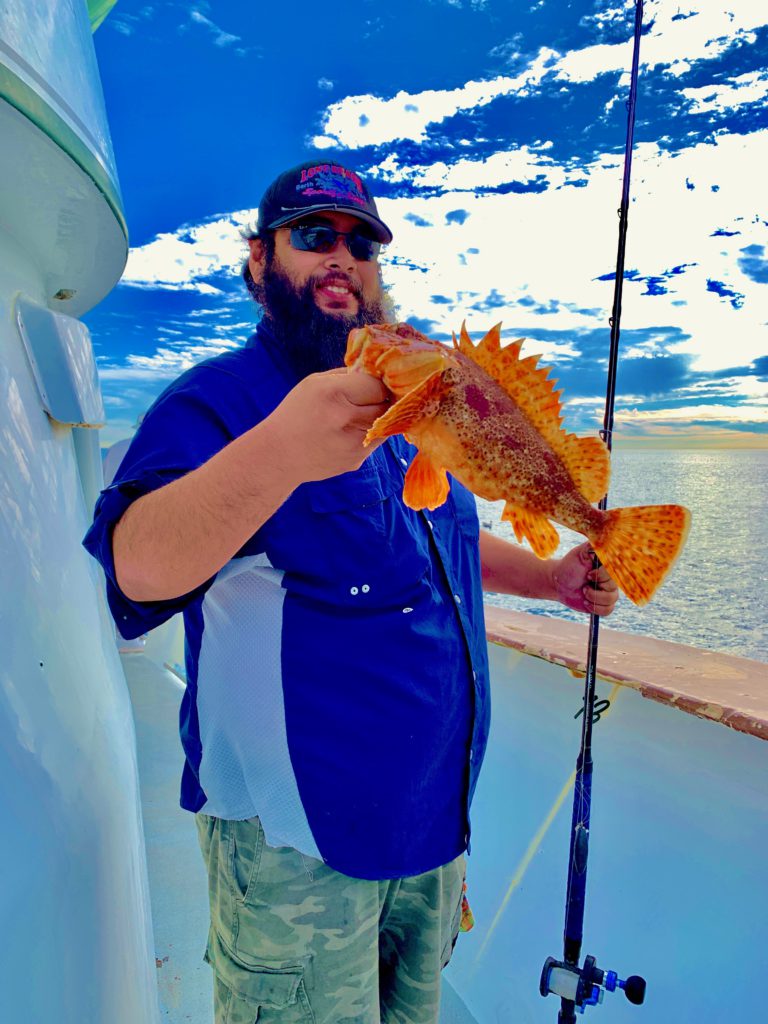
Slow growing, sculpin spawn at 3- to 4-years of age, typically from April through August, and generally do their procreating at night. Eggs are embedded in two gelatinous walls of hollow, pear-shaped egg sacks that reach five- to 10-inches long and contain a single layer of eggs. They’re released on the bottom and float to the surface, hatching within five days.
2 – Tackle tips
Sculpin fishing is pretty simple compared to fishing for other species. Most any medium to heavy rod will do, preferably with a reel filled with braided line. The braid will allow you to feel the bites better due to its lack of stretch. Because you’ll be fishing in heavy structure, a short top shot of 25- to 30-pound fluorocarbon is a good idea for its abrasion resistance.
Most anglers use a double dropper loop rig with anywhere from a 4- to 8-ounce torpedo sinker on the bottom, depending upon the depth and current. Using fluorocarbon for tying your dropper loop is also a good idea. Over the last few years, this rig has been refined somewhat.
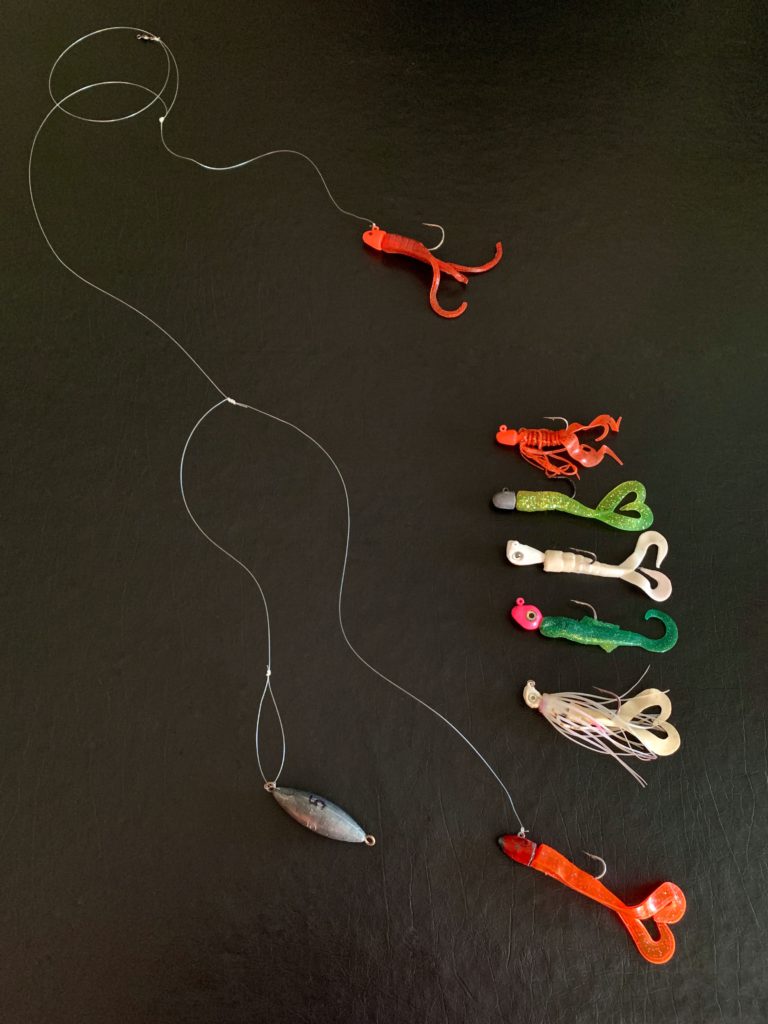 As Brian Burrell, deck boss of the Monte Carlo half-day boat recently shared, “The key to catching sculpin is keeping your bait right on the bottom. Use a 1/2- to 1-ounce leadhead with a Scampi or some other type plastic on it, tied onto each dropper loop, with a strip of squid pegged to the hook below the plastic. You want to use a leadhead instead of a bare hook so that its weight keeps your bait on or very close to the bottom and the plastic adds a life-like wiggle in the current. And for added insurance, tie your bottom loop long enough so that it’s always at or below the depth of your sinker. That will make sure that at least one of your baits will stay right on the bottom.”
As Brian Burrell, deck boss of the Monte Carlo half-day boat recently shared, “The key to catching sculpin is keeping your bait right on the bottom. Use a 1/2- to 1-ounce leadhead with a Scampi or some other type plastic on it, tied onto each dropper loop, with a strip of squid pegged to the hook below the plastic. You want to use a leadhead instead of a bare hook so that its weight keeps your bait on or very close to the bottom and the plastic adds a life-like wiggle in the current. And for added insurance, tie your bottom loop long enough so that it’s always at or below the depth of your sinker. That will make sure that at least one of your baits will stay right on the bottom.”
Remember too, to use a leadhead with a hook shank that’s long enough to have room to thread on squid strips or whatever bait you’re using in addition to the plastic on the leadhead. You’ll see anglers using a variety of different colored plastics. Pink, orange, chartreuse and white are commonly seen. Does color really make a difference? Some think so, I’m not convinced.
3 – Putting the odds in your favor
Most moderately experienced anglers know the basics of rigging for sculpin as noted above. But there are a handful of things to be aware of that can increase the odds of putting a five-fish limit in your sack.
First, you want to feel your sinker bouncing off the rocky structure of the bottom at all times. If you don’t feel the rocks or hard bottom, your chances of getting bit are slim. If you’re not over the right kind of bottom, look around the boat to see if there are any clusters of anglers getting bit. They’re probably over the rocks. And if you see a crewmember or the captain pick up a rod, watch where they’re fishing. They’ll likely pinpoint the alpha spot for you. Try to move into that area if there are open spots at the rail or politely ask, “Mind if I slide in next to you?” Courtesy pays off.
Frequently, the wind or current will have the boat swinging on the anchor, causing the stern to move on and off the structure unless it’s a really a wide spread of rocks. To minimize losing the spot when the boat swings, fish up the side of the boat, from mid-house to the bow. The pendulum swing of the boat is considerably less up there and your odds of staying over the structure are much better. More time over the structure can mean more fish in your bag.

Most of the time, the popular bait is frozen squid that the deckhand will cut into long thin strips to add to your leadhead and plastic. But there are times when something different gets the sculpin’s attention. Could be squid heads, or filleted or cut sardines. Ask the deckhand what’s been working best the last couple trips. Even if you were out last week and did well on squid strips, maybe there are anchovies in the tank that haven’t been available in a while. The crew wants you to catch fish as much as you do. Take their advice.
Once in a while, if someone catches a small whitefish or mackerel, the deckhand may strip them out for bait. There’s usually a limited supply of these oily fish-attracting baits and if so, the deckhand may hand them to a select few on the boat. If you’re a regular on the boat and have tipped the crew well in the past, you may be the guy who gets tapped on the shoulder and handed the primo bait. (Hint, hint.)
Sometimes a single dropper loop will get bigger fish, especially with bigger baits like a whole squid or slab of mackerel. Or a live sardine or anchovy pinned on a small hook on a reverse dropper loop might be just the ticket. If you’re close to your five-fish limit, it’s a good idea to mix it up and experiment a little to try for that moose sculpin.
4 – How to safely handle sculpin
The best advice I can give on how to handle a sculpin is…don’t. Let the crew unhook them for you and put them in your sack. On most party boats, they’ll be running around unhooking anglers’ fish and sacking them up for you. You might have to wait a minute or two, but it’s the safest way to avoid getting stuck.
If there are a lot of sculpin being caught and you choose to unhook the fish yourself instead of waiting for help, there’s really only one safe way to do it. Make a fist and use your thumb and forefinger to grab them by the lower lip, and hold them so that the fish is perpendicular to your hand. You’ll find that the weight of the fish usually causes the mouth to open, and much like a lipping a bass, it almost immobilizes them. Then using your other hand, grab the leadhead and carefully ply the hook loose. If you try to get the hook out any other way you run the risk of the fish flopping around and sticking you with one of its spines. If the leadhead is tough to break free, use a pair of pliers to get more leverage and add a few inches of safe space between your hand and their mouth.
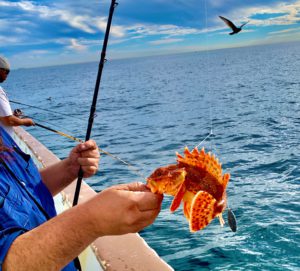
GRIP ‘EM BY THE LIP – The safest way to handle a sculpin is to let a deckhand unhook it for you. If you do it yourself, the only safe way is to firmly grip it by the lower lip with your thumb and forefinger and keep it perpendicular to your fist to avoid being stuck by the spines in their dorsal, pectoral or anal fins.
If there’s time, some deckhands will give the sculpin a “haircut” before depositing them into everyone’s sacks. They’ll use their dykes to clip the dorsal, anal and pectoral fins off, to prevent them from stinging someone. Not foolproof, but it definitely helps. If this barbering doesn’t happen, be careful if you go to the bait tank to get a fresh bait. You don’t want to lean against the sacks hung around the bait tank and be the one to find the lone sculpin spine sticking through the gunnysack with your leg or more delicate body parts. “Ouch” is an understatement.
5 – What to do if a sculpin sticks you
Any of the spines on the fins of a sculpin, and possibly the sharp little stickers on the head, can carry poison, whether alive or dead. If you fish long enough, you’ll probably get to experience the reason why they’re nicknamed rattlesnakes. I’ve caught lots of sculpin and have been nicked once or twice without much problem, but earlier this year I got stuck deep in two places as I was dropping a sculpin into my sack and I can confirm, it hurts like hell.
If a spine barely penetrates your skin, chances are you won’t feel it unless you’re a person who is highly allergic to bee stings or other foreign substances. If you do get stuck deeply, especially if it draws blood, you need to act quickly to prevent the spread of the venom and subsequent pain.
There are several fish tales about how to relieve the pain that are dubious at best. I’ve heard everything from rubbing chewing tobacco or Adolph’s Meat Tenderizer on it, to dousing it with bleach or vinegar. Some say urinating on the wound will help but the low ammonia levels in urine will only treat the surface of the skin and if you can’t pee on it yourself because the sting is not reachable, asking someone to pee on it for you is going to raise some eyebrows. Or get you smacked upside yo’ head.
Probably 90 percent of stings are going to be to your fingers or hand. The best remedy is to immediately (don’t wait until the pain is unbearable) soak the wound in hot water (even coffee), as hot as you can stand without burning yourself. Let it soak for 15- to 30-minutes. The heat should denature or break up the proteins in the poison and alleviate the pain, and you’ll be back at the rail before you know it.
In severe cases or if you wait too long and the toxins get into your blood stream, they can cause swelling and intense pain that can spread. I’ve seen someone get stuck on their finger and the swelling and pain spread to their entire forearm. Extreme reactions, especially those caused by multiple stings, can cause nausea, dizziness, respiratory and abnormal heart problems and may require a trip to the ER, though this is rare. I once heard about a kid that had a gunnysack full of sculpin and when getting off the boat, unknowingly swung the sack over his shoulder. Owww! I can’t imagine how many spines stuck him and how much pain he endured, but I bet he’ll never do that again.
Don’t let the possibility of getting stuck discourage you from fishing for sculpin. So long as you’re careful, and let the crew handle your fish for you whenever possible, you’ll be fine. They’re fun to catch and are one of the best-eating fish you’ll ever take from our local waters. Even though the fillets are relatively small, they’re great fried or sautéed and perfect for making fish tacos that your whole family will love. Chances are, they’ll love them so much that they’ll be begging you to catch more. Darn. I guess that means you’ll just have to go fishing more often.
